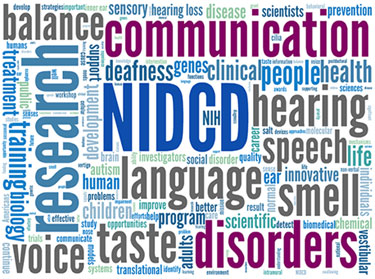October 28, 2013, marked the 25th anniversary of the founding of the NIDCD, and 25 fruitful years of funding research in its mission areas of hearing, balance, taste, smell, voice, speech, and language. During these years, NIDCD-supported scientists have made astonishing advances and numerous discoveries that have had a powerful impact on the health and quality of life of the American people. Here are some highlights of the past 25 years.

Hearing
At a landmark NIH consensus development conference in March 1993, experts endorsed the screening of all newborns for hearing loss before leaving the hospital. The recommendation was based on research showing the importance of early interventions and cost-effective methods for universal screening, which had been developed by NIDCD-supported researchers. Combined with similar recommendations by the Joint Committee on Infant Hearing, and further research and workshops supported by the NIDCD, universal newborn hearing screening was put into action in 1999 with Public Law 106-113, the Newborn Infant Hearing and Screening and Intervention Act. The law authorized the NIDCD, Centers for Disease Control and Prevention, and the Health Resources and Services Administration to support and coordinate statewide newborn and infant hearing screening programs as well as additional research. As of 2010, 96 percent of U.S. newborns are screened for hearing loss shortly after birth, up from as few as one-tenth in 1993, when only infants considered at high risk were screened.
Taste and Smell
In October 2004, NIDCD-funded scientist Linda Buck, Ph.D., won the Nobel Prize in Physiology or Medicine for clarifying how the olfactory (sense of smell) system works on molecular and cellular levels.
Voice, Speech, and Language
In December 2009, researchers identified gene KIAA0319 and associated it with Specific Language Impairment (SLI), a language disorder that affects seven percent of 5- to 6-year-old children. The NIDCD has a long history of research funding related to SLI, including a large epidemiologic study to establish the incidence of the disorder, the development of assessment tools to identify SLI in children who are bilingual, studies to show the possible neural bases of the disorder, and the development of treatment/learning strategies to address language deficits.
Balance
In October 2010, researchers implanted the first vestibular device to stop the severe vertigo associated with Ménière's disease, which affects 600,000 people a year in the U.S. Using the technology found in a cochlear implant, the device attempts to stop a Ménière's attack by restoring a stable pattern of electrical activity in the vestibular nerve of the damaged ear. Earlier funding, beginning in 2006, supported preclinical animal studies and development of the neural prosthesis used in this clinical study.

